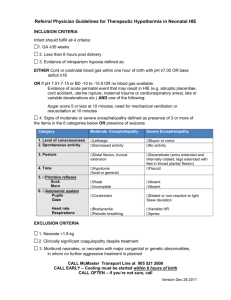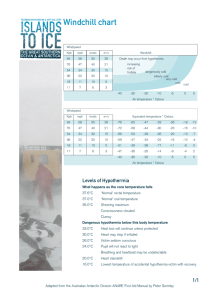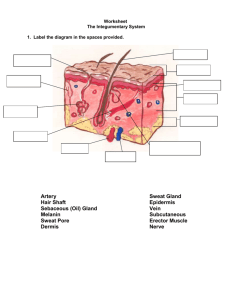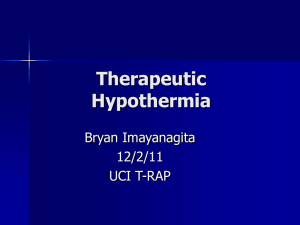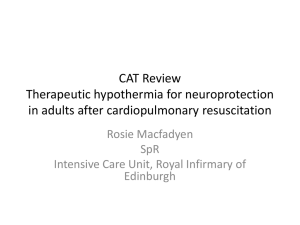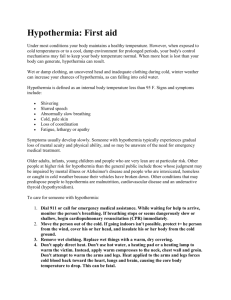History - Pediatrics House Staff
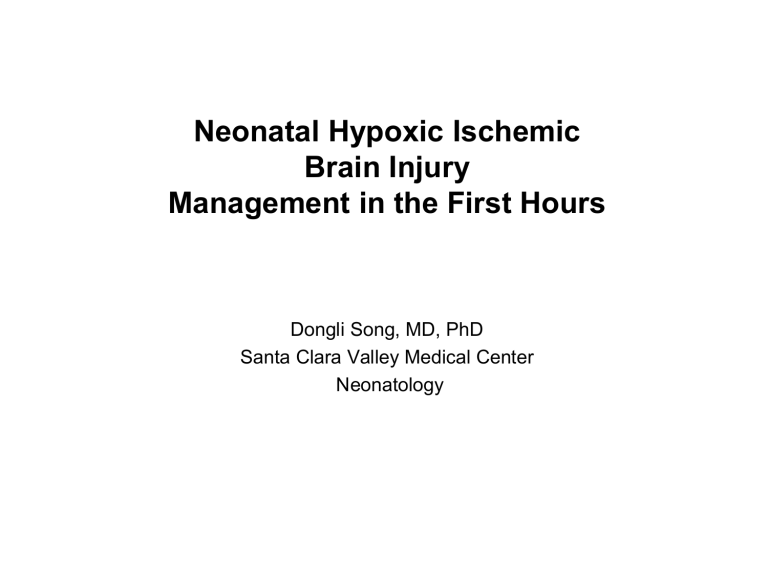
Neonatal Hypoxic Ischemic
Brain Injury
Management in the First Hours
Dongli Song, MD, PhD
Santa Clara Valley Medical Center
Neonatology
History
• Baby girl F, born to a 35 year old G
5
P
4 mother with good antenatal care. This pregnancy complicated by GDM, diet control.
• Blood group O positive; Hep B neg: HIV neg:
RPR neg: Rubella immune: GBS negative
• Mom admitted at 37+2 weeks with active vaginal bleeding. US showed placenta abruption.
Pediatric team get called to the DR stat
• Infant was delivered via stat c/s.
• At delivery, she was floppy with no respiratory effort and no heart rate.
• Bag and mask ventilation started immediately, HR > 100 bpm at 3 min, and some respiration effort noted at 5 min.
She was intubated at 7 min for poor sustained respiration. Color improved but remained floppy at 10 min. Apgar score 0@1 min; 4@ 5 min; 5@ 10 min .
What should you ask OB/L&D staff in the DR?
Get cord blood gas
Answer: ask OB/L&D staff to send cord blood gas.
Cord arterial gas: pH 6.8, PCO2 103, Bicarb 15 and
BD19.7
• Cord blood gas provides critical information regarding the severity and/or duration of hypoxic ischemic insults prior to delivery.
• Cord arterial gas (from UA) is a part of the criteria for hypothermia treatment.
• If cord blood gas is not available, get infant ABG within first hour of life.
Physical examination
• Weight 3720gms (>90%), OFC 35.5 cm (90%), Length
54.4 (>90%)
• Temperature 36.5
o C
• HR 190bpm, BP 37/23 mmHg.
• Pale and poor perfused
• On ventilator with periodic respiration effort
• No significant dysmorphic features
Neurological examination
• Does this infant display encephalopathy?
• How could the neurological examination have been done/documented to show this?
Neurological examination
A systemic detailed neuro exam were performed and documented:
• Level of Consciousness: poor eye opening to stimulation, no sustained alertness
• Movements and Tone: minimal spontaneous activity, hypotonia
• Brainstem/Autonomic Functions: pupils constricted but reactive, no suck, no gag
• Reflexes: incomplete Moro, no DTR
NICHD Exam Criteria for Hypothermia
Moderate
Encephalopathy
Severe
Encephalopathy
1. Consciousness Lethargic Stupor/coma
2. Activity Decreased No Activity
3. Posture Distal Flexion Decerebrate
Flaccid 4. Tone
5. Primitive Reflexes
Suck
Moro
6. Autonomic
Pupils
Heart Rate
Respirations
Hypotonia (focal or general)
Weak
Incomplete
Constricted
Bradycardia
Periodic
Absent
Absent
Fixed; Unequal
Variable HR
Apnea
Lab tests
Your initial lab work should include following :
A. Check blood glucose
B. CBC
C. BCx
D. Chem 7
E. LFTs
F. Coagulation tests
Lab tests
Answer : All above.
• Correcting hypoglycemia is critical for brain protection.
• Mom had placenta abruption, HCT and platelet count will help to determine if blood product transfusion is indicated.
• Increase in creatinine indicates kidney injury, and elevation of LFTs and coagulopathy indicates liver damage.
Lab results
• Cord arterial gas: pH 6.8, PCO2 103, Bicarb 15 and BD 19.7.
• Blood glucose 15
• CBC: WBC 17.7k, HCT 30%, platelet count
141K
• Creatinine 1.3
• AST 945, ALT 220
• PT/PTT/INR significant prolonged
Antepartum Risk Factors
• Socioeconomic
Status
• Family History
• Infertility treatment
• Maternal thyroid disease
• Severe pre-eclampsia
• Bleeding in pregnancy
• Viral illness
• Abnormal placenta
• IUGR
• Postmaturity
Intrapartum Risk Factors
• Operative vaginal delivery or emergency Csection
• Maternal fever
• Occipito-posterior presentation
• Acute intrapartum events: cord prolapse, abruptio placentae…
Heterogeneous cause
Badawi N. et al. BMJ.1998
Hypothermia treatment
One hour later, fluid boluses were given, hypoglycemia was corrected and FFP transfusion was started. Infant started to have spontaneous respiration effort and movements and her tone improved.
Your next treatment plan include:
A.
Start hypothermia treatment ASAP
B.
Obtain brain imagine to confirm hypoxic-ischemic brain injury before start hypothermia treatment
C.
Continue monitoring. Hypothermia will not be indicated if infant’s condition significantly improved at 6hr of life.
Hypothermia treatment
Answer: A and B
Diagnosis of Neonatal Encephalopathy is Clinical
• Careful history and neurological exam
• Laboratory studies to exclude “mimics” of hypoxiaischemia
– Metabolic abnormalities
• including inborn errors of metabolism
– Infection
– Acute bilirubin encephalopathy
– Stroke
Diagnosis – Neuro imaging
HUS - may detect basal ganglia and thalamic injury, not sensitive to cortical injury. Most useful in detecting and following intracranial bleeding.
CT - can detect diffuse cortical neuronal injury, most useful to r/o intracranial hemorrhage that requiring immediate surgical intervention. Concerns for radiation.
MRI - is the study choice of assessing HI brain injury. It provides specific information regarding the injury pattern, severity and evolution.
Neuro imaging is not an absolute requirement for initiating hypothermia treatment for HIE.
Cortical Injury
Chao, C. P. et al. Radiographics 2006;26:S159-S172
Copyright ©Radiological Society of North America, 2006
Basal Ganglia Injury
Parent’s questions
You talked to infant’s father and explained to him that the his baby is critically ill and may have suffered serious brain injury.
He asked:
• What causes her brain injury?
• Is my baby going to die?
• If she survived, will she be normal?
• What can you do to save my baby?
Significance
• Incidence of HIE: 1-2/1000 live births
*California: 4.5/1000 live births
• HIE is a major cause of infant mortality and morbidity with significant long term neurological deficits:
• 15 - 20% die in infancy and 20 -25% survived with some neurological abnormalities including cerebral palsy, cortical visual impairment, seizures, developmental delay and mental retardation .
Hypothermia treatment
• Neonatal encephalopathy is a neurological emergency.
• Brain injury evolves over time.
• Biphasic nature of cell death (Gluckman PD, et al
1992): Primary neuronal death (cell hypoxia/primary energy failure). Latent period – at least 6 hours. Secondary phase - delayed neuronal death begins.
Mechanisms of ischemic brain injury
Hypoxiaischemia
Primary neuronal death
1 hour
Cytotoxic mechanisms
6 hours
Delayed neuronal death
Days
Hypothermia
Modified from Gunn and Thoresen, 2006
Mechanisms of ischemic brain injury
Ferriero D. NEJM 2004
INCLUSION
≥36wks GA and ≥ 1800gms
Meet both Physiologic and Neurological Criteria
No “Lethal” chromosomal or congenital anomalies
PHYSIOLOGIC CRITERIA
Cord or Baby’s ABG < 1 hour
No gas <1hr
OR pH 7.01-7.15 and BD 10-15.9
Plus
A MAJOR PERINATAL EVENT nonreassuring FHR cord prolapse/rupture, uterine rupture, maternal trauma, abruption, hemorrhage, CPR,
AND
Apgar
≤
5 at 10 min, or PPV
≥
10 min pH ≤ 7.0
OR
BD ≥ 16
MEET
PHYSIOLOGI
C CRITERIA
AND
Cooling
MEET
NEUROLOGIC
CRITERIA
NEUROLOGIC EXAM CRITERIA
Moderate Encephalopathy
3 of 6 findings below
1. Lethargic
2. Inactive/decreased activity
3. Distal flexion
4. Hypotonia- focal or general
5. Weak suck/incomplete moro
6. Pupil constricted/ Bradycardia / periodic breathing
OR
Severe Encephalopathy
3 of 6 findings below
1. Stupor/coma
2. No activity
3. Decerebrate
4. Flaccid tone
5. Absent suck/moro
6. Pupils dilated /unreactive /skew, variable HR, apnea
OR
Seizure
Clinical or Electrical
Based on NICHD total body cooling protocol
Hypothermia treatment
Whole Body Cooling cooling blanket > esophageal temp 33.5
o C for 72hrs
Select Head Cooling
Cooling Cap > rectal temp 34-35 o C for 72hrs
Hypothermia Trials:
50%
Cooled Babies had Poor
Outcomes
Cooled Controls
Died or severe disability 44-55%
Died
Bayley MDI < 70
Bayley PDI < 70
24-33%
25-30%
27-30%
62-66%
38%
39%
35-41%
NICHD and CoolCap trials, Lancet and NEJM 2005
Hypothermia treatment improves outcome
Hypothermia treatment
Potential adverse effects
-Hypotension
-Cardiac arrhythmia (mainly sinus bradycardia )
-Persistent acidosis
-Increased oxygen consumption
-Increased blood viscosity
-Reduction in platelet count
-Pulmonary hemorrhage
-Sepsis
-Necrotizing enterocolitis
no severe side effects have been reported so far
Best patient care depends on
• Close communication with family
• Multidisciplinary care
• Neurology– neurological examination
(structured /routine), diagnosis, prognosis, follow up
• Radiology – timing and interpretation
• Physical and occupational therapy – evaluation, pre-discharge examination
Thank you!

